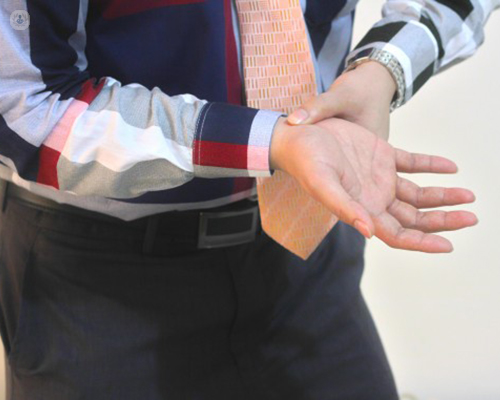Common hand and wrist conditions
Escrito por:When nerves in our hands, wrists and elbows become compressed we can experience problems with our grip strength, dexterity, as well as pain and discomfort. Two of the most common hand and wrist conditions are carpal tunnel syndrome and cubital tunnel syndrome. If you frequently experience numbness or tingling in the fingers or arm, it could be one of these disorders. Mr Andrew Fitzgerald, an experienced orthopaedic surgeon and expert in treating hand, wrist and elbow problems, summarises these common conditions.

Carpal tunnel syndrome
Carpal tunnel syndrome is a condition where the median nerve, as it crosses the front of the wrist, is compressed within a tunnel at the wrist, which also contains the tendons that bend the fingers and thumb. The condition can affect any age and affects both men and women, but it is common in middle-aged women.
Symptoms:
Carpal tunnel syndrome typically causes altered sensation, tingling and numbness affecting the hand and fingers. It usually affects the thumb, index, middle and ring fingers. The symptoms are often worse at night and in the mornings and can affect sleep. It is not uncommon that it is associated with pain in the hand and wrist and, occasionally, pains radiating up the arm.
The symptoms of carpal tunnel syndrome may be intermittent initially, but as it progresses the tingling and numbness may become more constant and weakness may develop leading to clumsiness and a tendency to drop things.
Diagnosis:
The diagnosis of carpal tunnel syndrome can be confirmed by carrying out nerve conduction studies, which involves placing electrodes on the skin to stimulate the nerves and measure their responses. By doing this, the speed of nerve conduction and the signal strength can be measured. If the nerve is compressed, both the speed of conduction and signal will drop and the diagnosis can be confirmed, as well as the severity of the problem.
Treatment:
The treatment of carpal tunnel syndrome will depend on the severity of the problem, but conservative treatments using splints, particularly at night, and the use of steroid injections into the carpal tunnel can help relieve symptoms. Surgery is often needed if conservative measures fail and symptoms are severe or progressive.
The operation is usually carried out under local anaesthesia but can be carried out under general anaesthetic. The procedure involves making an incision over the front of the wrist, which is approximately 2-3cm long and opening the roof of the tunnel to relieve the pressure on the nerve. The hand will be bandaged for 10-14 days, at which time the stitches will be removed and then gradually increasing the use of the hand. The vast majority of patients will return to all of their activities over a period of 2-3 months.
The success rate of the operation is up to 90%, with regards to the relief of symptoms.
Cubital tunnel syndrome
Cubital tunnel syndrome is due to compression of the ulnar nerve as it passes through a tunnel on the inside of the elbow.
Symptoms:
Compression of the ulnar nerve typically causes tingling or numbness, affecting the little and ring fingers in the hand, which initially may be intermittent, but as the condition progresses, may become more severe and constant. The nerve supplies the small muscles within the hand and as the condition progresses there may be weakness developing in the hands with loss of grip strength and dexterity. Muscle wasting can also develop.
Diagnosis:
Investigation of cubital tunnel typically involves performing nerve conduction studies to confirm the diagnosis and also the severity of the nerve problem.
Treatment:
The treatment of the condition will depend on the severity of the condition, but conservative measures should be tried initially. These involve avoiding activities where the arm is bent for long periods or leaning on the elbow, which can worsen the symptoms.
In cases which do not respond to conservative treatment or those which are severe or progressive, then surgical intervention is required in the form of a cubital tunnel decompression (ulna nerve release). This typically involves opening the roof of the tunnel over the medial aspect of the elbow to relieve the pressure on the nerve. Depending on the cause of the problem, surgery can also involve moving the nerve to the front of the elbow (transposition) or it can involve the removal of bone.
The recovery of the nerve after the surgery will depend on the severity of the initial problem, but in mild or moderate cases, the symptoms will fully resolve in the majority of cases. In more severe nerve compression, the outcome is less predictable and there may be incomplete recovery, which can be slow. However, surgery will generally prevent worsening of symptoms in such cases.


